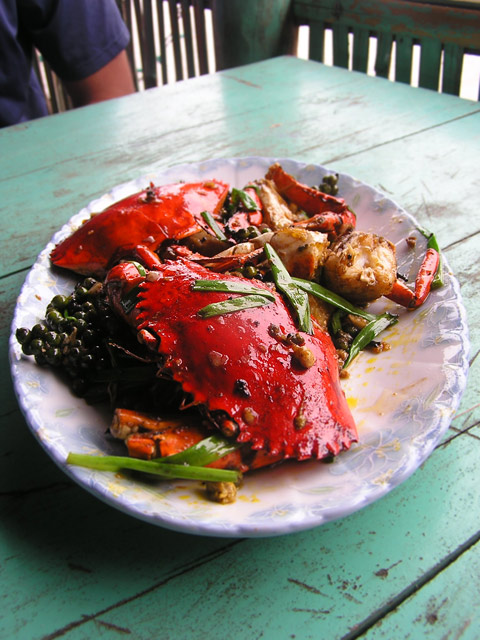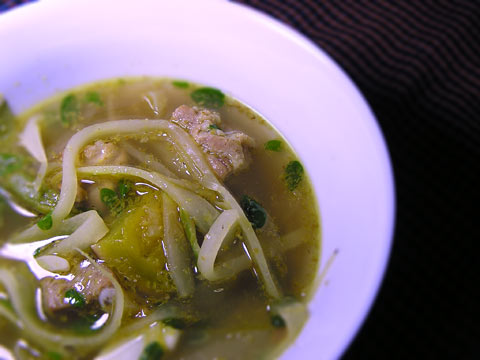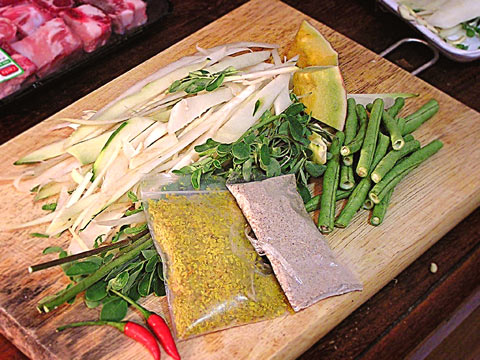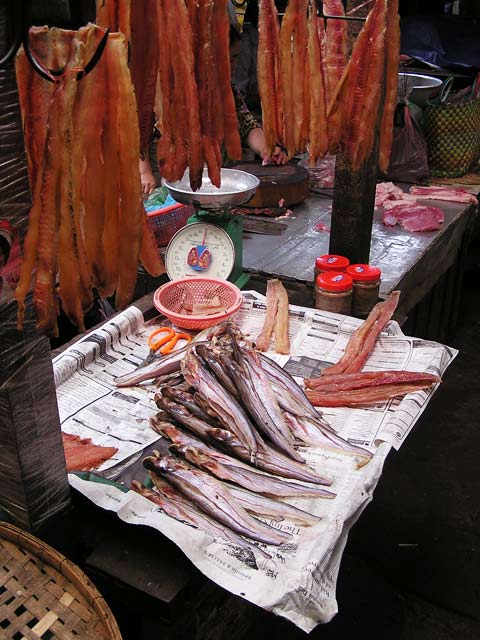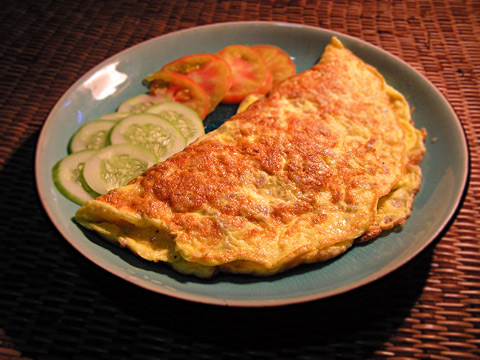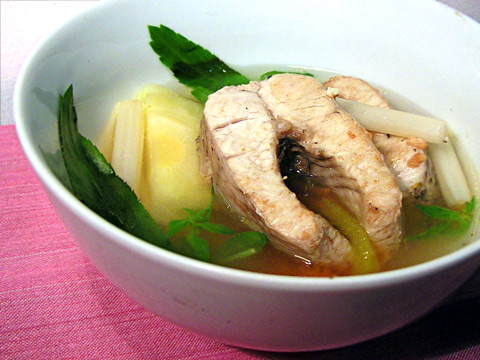Two loc lac recipes and a mercifully short digression on authenticity.
Loc Lac (occasionally, lok lak) is a superb expression of Cambodia’s recent colonial history and the imagined authenticity that is generally transferred by foreigners onto Asian food; an authenticity that is mirrored by the way that Khmer national culture itself is constructed. Loc Lac comes to Cambodia via Vietnam where it is named bo luc lac (literally, “shaking beef” in Vietnamese) and was most likely brought to Cambodia with the French colonisers rather than with the Vietnamese. At some point within the last 50 years, Cambodia has wholly claimed it as part of Khmer cuisine – so much so that it would be literally unimaginable for most Cambodians that the dish was originally Vietnamese. Somewhere along the line, an enterprising Cambodian added French fries (dumlon barang chien) as a typical accompaniment.
Like fish amok, loc lac tends to be a favourite with foreigners who also tend to confuse it for something much older, more Khmer and therefore somehow more authentic. What could be more authentically Asian than beef stir-fried with commercial ketchup and soy sauce, then served with a side of fries? I suspect that much of its popularity also comes from loc lac hitting directly within the Western palate and being packed full of umami-ness thanks to the folks at Ajinomoto.
“Authentic” loc lac recipe
This recipe is the result of me chatting to the chef from the cafeteria in the building where I work, watching him cook loc lac, then running a brief straw poll of workmates and friends. There is no canonical version. While beef is the most common meat used, pork, chicken or occasionally venison (see second recipe) do come into play. Often the marinating step is removed entirely, and the beef is immediately stirfried with garlic and oil instead, or the sauce/oil is cooked together with the beef. The sauce elements seem to be interchangeable depending on availability – but there was some consensus that the sauce should appear brown in colour and contain the key components of oil, sugar and MSG.
Ingredients:
150g beef, in 2cm cubes
For marinade:
2 tbsp chopped garlic
2 tbsp soy sauce
1/2 tsp salt
For sauce:
1 tbsp tomato sauce (ketchup) and 1 tbsp oyster sauce – There is some contention whether to use rice wine; oyster, soy or fish sauce; or combinations thereof. Neither oyster sauce nor ketchup are used widely in Khmer cooking, so I suspect that most times these two tablespoons are a mix of soy and fish sauce, or just fish sauce, thickened with corn flour.
1/2 tbsp sugar
3 tbsp cheapest cooking oil available
1 tsp MSG
1 onion
1 greenish tomato
Tuk meric (pepper sauce) for dipping
1 tsp crushed/ground black pepper
1/2 tsp salt
2 tsp lime juice
Marinate beef in garlic, soy and salt for between 10 minutes and an hour depending on the toughness of your cut. Thinly slice the onion and spread in a single layer on your serving plate, and slice tomato for garnish.
Add cooking oil to wok, and heat until the oil shimmers and just begins to smoke. Add beef and marinade, stir fry until browned. Add sugar, oyster sauce, oil, tomato sauce, MSG. Once warmed through, pour onto your serving plate.
Serve with a side of fries (“Loc Lac American”), steamed rice and a dipping bowl of tuk meric. If you’re in a decadent mood, top with a fried egg.
“Inauthentic” forbidden loc lac recipe
Despite being illegal, local deer (sach chlouk) does get served occasionally in Cambodia’s Northern provinces as delicious loc lac. While the Cambodian judicial system may be corrupt to the core (with one shining exception), I still do my best to adhere to the rule of law and so will not be eating nor promoting any Cambodian venison for the moment. However, most of my readership live in deer-legal regions, so cooking a deer loin outside Cambodia in the manner of Cambodians raises no moral or legal quandaries. Restaurant Le Royale’s beef loc lac inspired this recipe which throws all pretence of authenticity out the window. It’s more Franco-Chinese than Sino-Vina-Franco-Khmer.
Ingredients:
250gms trimmed venison loin, cubed
For marinade:
2 tbsp chopped garlic
2 tbsp mushroom soy sauce
1 onion
2 tbsp peanut oil
For reduction sauce:
1/4 cup of red wine
2 cups of venison stock
1 tbsp Kampot pepper, removed from stalk
Tuk meric (Pepper Sauce) for dipping
1 tsp crushed/ground Kampot black pepper
1 tsp sea salt
2 tsp lime juice
Marinate the venison in chopped garlic and mushroom soy sauce for 10 minutes. Thinly slice the onion and spread in a single layer on your serving plate.
Add cooking oil to wok, and heat until the oil shimmers and just begins to smoke. Add venison and marinade. Stir fry quickly until the venison is browned. Remove the venison from the wok, and set aside.
Turn the heat down and let the wok cool a little. Add the 1/4 of a cup of wine and stir to lift the coagulated meat juices from the wok. Bring to the boil and add the stock and fresh Kampot pepper. Reduce to about half, salt to taste, then pour over the venison.
Serve with steamed rice and dipping bowl of tuk meric. If you’re in a decadent mood, top with a fried egg.

